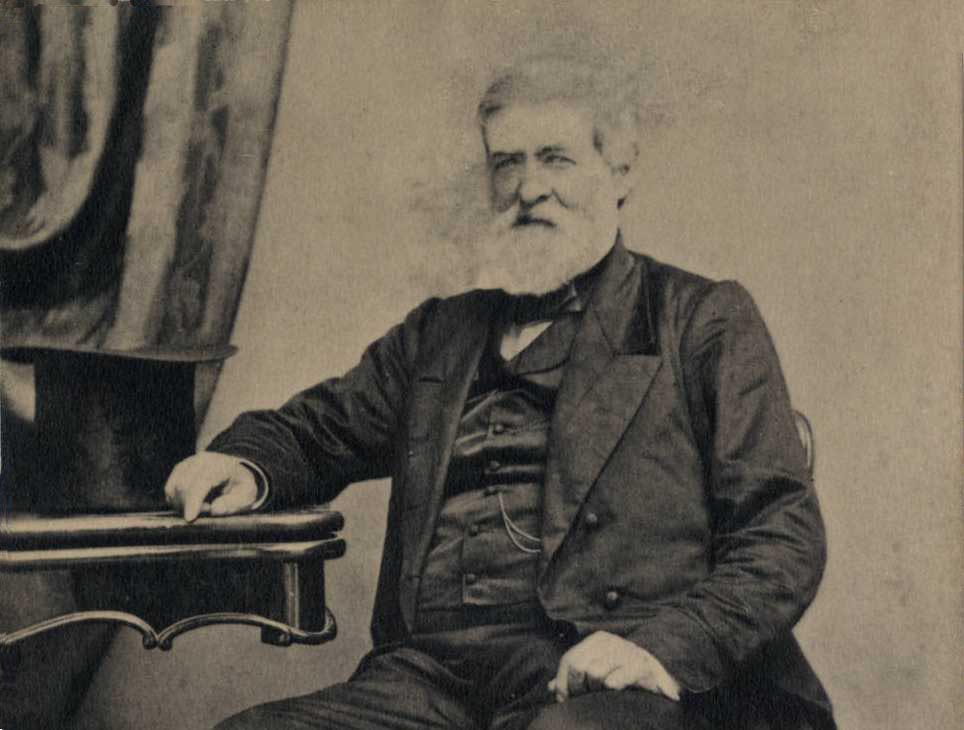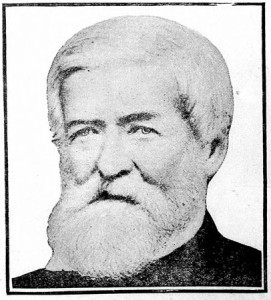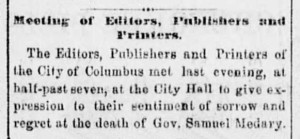Who Was Samuel Medary?

Praised by Democrats, denigrated by Whigs and Republicans, and a household name to all, Samuel Medary–the “Old Wheel-horse of Democracy”– was a 19th century newspaper publisher, politician and spokesperson for the Democratic Party in Ohio. Though he wore many hats throughout his lifetime, it was his journalistic endeavors that seemed to bring him the most acclaim… and infamy.

Medary was a native of Pennsylvania who moved to the town of Bethel in Clermont County, Ohio, in 1825, and shortly began his first paper in 1828. The Democratic Ohio Sunwas a staunch supporter of Andrew Jackson with the motto, “Unawed by the influence of the rich, the great or the noble, the people must be heard and respected.” Medary believed it was the responsibility of U.S. citizens to be informed of their nation’s happenings and be familiar enough with the Constitution to hold politicians and public servants accountable to its principles. He believed it was the responsibility of newspaper editors to help with these efforts (Krumm, 1978, pp. 42-44), and this philosophy was reflected in his editorial style.
Within months, the paper, and Medary, had moved to the county seat of Batavia, where he began his political career. He served as both a representative and senator in the Ohio General Assembly throughout the mid-1830s, and moved to the state capital, Columbus, in 1836. Two years later, he returned to journalism and began to edit the Ohio Statesman, the mouthpiece of the Ohio Democratic Party. The Statesman influenced newspapers around the state through its endorsement of Democratic candidates and policies, criticism of their Whig and Republican opponents and, for a time, position as the official state printer. This allowed Medary to “eschew advertising and to concentrate on political reportage, or, perhaps better put, political editorializing” (Krumm, 1978, p. 58). Medary was active in Democratic Party Conventions, both locally and nationally, and contributed to James Buchanan’s 1856 presidential nomination. His support of Buchanan led to his appointments as Territorial Governor of Minnesota in 1857 and of Kansas in 1858.

Medary returned to Columbus in 1860 and established a Copperhead (Peace Democrat) newspaper known as the Crisis. Lauded by the Dayton Daily Empire as “one of the best Democratic papers published in the West—or anywhere else,” the paper was comprised of editorials critical of President Abraham Lincoln, the Republican Party and the Civil War. These views were widely unpopular in a state dominated by Republican sentiment. Even the editor of the still-Democratic Ohio Statesman was at odds with Medary at one point: on October 24, 1861, the Holmes County Republican reported on “hostilities between the editors of the two Democratic papers published in [Columbus], which was inaugurated by a skirmish this morning, on State street, between Col. Medary… and Mat. Martin, Esq., editor of the Statesman.” Eventually, Medary’s controversial paper led to the destruction of his newspaper office by a mob of “indignant soldiers” on March 5, 1863. The offices of the Ohio Statesman were also attacked. The Statesman blamed “the Abolition papers and orators who constantly endeavor to inflame the people and lead them to acts of violence”; the Ohio State Journal, one of those so-named “Abolition papers,” denied this accusation vehemently, claiming these assertions were “utterly unfounded.”

The wheel of fortune that had once taken the “Old Wheel-horse” so high took him even lower the next year when he was arrested and charged with conspiracy against the government. He was said to have been connected to the “Thomas-Cathcart conspiracy,” a plot to release Confederate prisoners, including John Morgan, from Camp Chase. Medary’s case never went to trial as he died six months later on November 7, 1864. Democratic newspapers bemoaned his death, while some Republican newspapers barely gave it a mention. Despite his polarizing political ideas, a monument was erected in his honor in 1869 in Greenlawn Cemetery, Columbus. The accompanying inscription reads, “In commemoration of his public services, his private virtues, distinguished ability, and devotion to principle, this monument is erected by the Democracy of Ohio.”
Interested in learning more about Samuel Medary? Check out some of Ohio’s historic newspapers on Chronicling America, the Library of Congress’ digital newspaper database, and Ohio Memory! Papers from all over the country printed stories with varying opinions on this colorful character.
Thanks to Jenni Salamon, Coordinator for the Ohio Digital Newspaper Program, for this week’s post!
For further reading, see (available in the Ohio History ConnectionArchives/Library): Krumm, T. (1978). The Gethsemane factor: A historical portrait of Samuel Medary of Ohio and an analysis of the rhetorical dilemma of his Crisis years, 1861-1864. The Ohio State University: Columbus.



Leave a Reply
You must be logged in to post a comment.